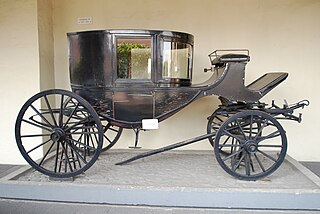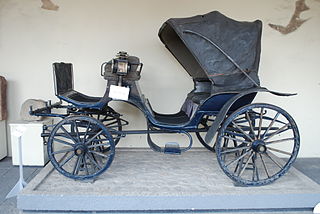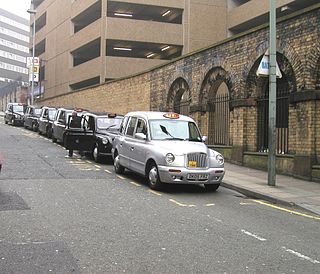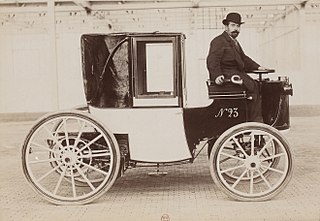 |  |
A fiacre is a form of hackney coach, a horse-drawn four-wheeled carriage for hire. In Vienna such cabs are called Fiaker.
 |  |
A fiacre is a form of hackney coach, a horse-drawn four-wheeled carriage for hire. In Vienna such cabs are called Fiaker.
The earliest use of the word in English is cited by the Oxford English Dictionary as from 1699 ("Fiacres or Hackneys, hung with Double Springs"). [1] The name is derived indirectly from Saint Fiacre; the Hôtel de Saint Fiacre in Paris rented carriages from about the middle of the seventeenth century. [2] Saint Fiacre was adopted as the cab drivers' patron saint because of the association of his name with the carriage. [3]
In 1645, Nicholas Sauvage, a coachbuilder from Amiens, decided to set up a business in Paris hiring out horses and carriages by the hour. He established himself in the Hôtel de Saint Fiacre and hired out his four-seater carriages at a rate of 10 sous an hour. Within twenty years, Sauvage's idea had developed into the first citywide public transport system: les carosses à 5 sous ("5-sou carriages"). These 8-seater carriages, forerunners of the modern bus, were put into service on five "lines" between May and July 1662, but had disappeared from the streets of Paris by 1679, almost certainly because of the spiralling cost of fares. [4]
Although the public transport system had suffered a temporary demise, private hirers were quick to fill the gaps with carriages including the "vinaigrette", a two-wheeled chair powered and guided by two people; the cabriolet, a dangerous two-wheeled buggy pulled by a single horse; and the more traditional four-wheeled fiacres. By the time of the Revolution there were more than 800 fiacres operating in Paris. [4]
In 1855, Napoléon III instigated a monopoly control of the fiacres of Paris via the Compagnie Impériale des Voitures à Paris (CIV), which by 1860 operated 3,830 fiacres and owned 8,000 horses; in this year the CIV carried over 10 million passengers. [5] Fiacre drivers earned about three francs a day, plus two francs in tips. [6] In 1866 the CIV lost its monopoly status and became a Société Anonyme. It began to use motorized vehicles in 1898 but was still operating 3500 horse-drawn vehicles in 1911. [7]
In the 1890s the Parisian music-hall singer Yvette Guilbert introduced a popular song, Le fiacre, in which an aged husband sees his wife in a fiacre with her lover. [8]
In Vienna such cabs are called Fiaker . [9] They featured in popular music, such as Gustav Pick's song, the "Fiakerlied". Fiaker and their drivers also featured in operas of Johann Strauss II and in Richard Strauss's opera Arabella (where the second act takes place at the fiaker-drivers' ball). [10]
Fiacres still survive in Vienna [9] and other European travel centres as tourist attractions.

A cart or dray is a vehicle designed for transport, using two wheels and normally pulled by draught animals such as horses, donkeys, mules and oxen, or even smaller animals such as goats or large dogs.

A carriage is a two- or four-wheeled horse-drawn vehicle for passengers. Second-hand private carriages were common public transport, the equivalent of modern cars used as taxis. Carriage suspensions are by leather strapping or, on those made in recent centuries, steel springs. Two-wheeled carriages are usually owner-driven.

A hackney or hackney carriage is a carriage or car for hire. A hackney of a more expensive or high class was called a remise. A symbol of London and Britain, the black taxi is a common sight on the streets of London. The hackney carriages carry a roof sign TAXI that can be illuminated to indicate their availability for passengers.

The hansom cab is a kind of horse-drawn carriage designed and patented in 1834 by Joseph Hansom, an architect from York. The vehicle was developed and tested by Hansom in Hinckley, Leicestershire, England. Originally called the Hansom safety cab, it was designed to combine speed with safety, with a low centre of gravity for safe cornering. Hansom's original design was modified by John Chapman and several others to improve its practicability, but retained Hansom's name.

Fiacre is the name of three different Irish saints, the most famous of which is Fiacre of Breuil, the priest, abbot, hermit, and gardener of the seventh century who was famous for his sanctity and skill in curing infirmities. He emigrated from his native Ireland to France, where he constructed for himself a hermitage together with a vegetable and herb garden, oratory, and hospice for travellers. He is the patron saint of gardeners.

A kalesa, is a two-wheeled horse-drawn carriage used in the Philippines. It is commonly vividly painted and decorated. It was a primary mode of public and private transportation during the Spanish colonial era of the Philippines, though in modern times, they largely only survive as tourist attractions, such as in Vigan, Ilocos Sur.

A clarence is a type of carriage that was popular in the early 19th century. It is a closed, four-wheeled horse-drawn vehicle with a projecting glass front and seats for four passengers inside. The driver sat at the front, outside the carriage. The clarence was named after Prince William, Duke of Clarence and St Andrews, later King William IV of the United Kingdom, who died in 1837. It was introduced in 1840 in London. The Brougham was a lighter, two-passenger version originally commissioned by Lord Brougham.

Paris is the centre of a national, and with air travel, international, complex transport system. The modern system has been superimposed on a complex map of streets and wide boulevards that were set in their current routes in the 19th century. On a national level, it is the centre of a web of road and railway, and at a more local level, it is covered with a dense mesh of bus, tram and metro service networks.

A horse-drawn vehicle is a piece of equipment pulled by one or more horses. These vehicles typically have two or four wheels and were used to carry passengers or a load. They were once common worldwide, but they have mostly been replaced by automobiles and other forms of self-propelled transport but are still in use today.

The victoria is an elegant style of doorless four-wheeled open carriage, drawn by one or two horses, based on the phaeton with the addition of a coachman's seat at the front, and with a retractable roof over the passenger bench.
Nicolas Jean-Baptiste Ravot, seigneur d'Ombreval was a French magistrate and administrator who served as Lieutenant General of Police of Paris from 1724 to 1725.

Taxicabs are regulated throughout the United Kingdom, but the regulation of taxicabs in London is especially rigorous with regard to mechanical integrity and driver knowledge. An official report observed that: "Little however is known about the regulation by anyone outside the trade. The Public Carriage Office (PCO), which regulates and licenses taxis and private hire was transferred from the Metropolitan Police to become part of Transport for London in 2000." In 2015, there were around 298,000 licensed drivers in England, of which 164,000 were private hire licences, 62,000 were taxi licences and 72,000 were dual licences.

The Jeantaud was a make of French automobile manufactured in Paris from 1893 until 1907. It was the brainchild of Charles Jeantaud, a coachbuilder who built his first electric carriage in 1881. Among the vehicles he constructed was the first car to set a land speed record at 63.15 km/h (39.24 mph), driven by Gaston de Chasseloup-Laubat, as well as coupes and hansom cabs; in these the driver sat high, and to the rear. Some cars had an unusual bevel-gear front-wheel-drive layout. From 1902 to 1904, Jeantaud offered a range of 2-, 3- and 4-cylinder gasoline-engined cars similar to 1898 Panhards.

The Metropolitan Conditions of Fitness for Taxis set out the requirements for vehicles that may be used as licensed Hackney carriage taxi cabs in London. They are what makes London's taxis unique in the world and are governed by Transport for London's Taxi and Private Hire office.

A coach is a large, closed, four-wheeled, passenger-carrying vehicle or carriage usually drawn by two or more horses controlled by a coachman, a postilion, or both. A coach has doors in its sides and a front and a back seat inside. The driver has a raised seat in front of the carriage to allow better vision. It is often called a box, box seat, or coach box. There are many of types of coaches depending on the vehicle's purpose.

A cabriolet is a light horse-drawn vehicle, with two wheels and a single horse. The carriage has a folding hood that can cover its two occupants, one of whom is the driver. It has a large rigid apron, upward-curving shafts, and usually a rear platform between the C springs for a groom. The design was developed in France in the eighteenth century and quickly replaced the heavier hackney carriage as the vehicle for hire of choice in Paris and London.

A taxi, also known as a taxicab or simply a cab, is a type of vehicle for hire with a driver, used by a single passenger or small group of passengers, often for a non-shared ride. A taxicab conveys passengers between locations of their choice. This differs from public transport where the pick-up and drop-off locations are decided by the service provider, not by the customers, although demand responsive transport and share taxis provide a hybrid bus/taxi mode.

Rickshaw originally denoted a pulled rickshaw, which is a two- or three-wheeled cart generally pulled by one person carrying one passenger. The first known use of the term was in 1879. Over time, cycle rickshaws, auto rickshaws, and electric rickshaws were invented, and have replaced the original pulled rickshaws, with a few exceptions for their use in tourism.
The Hôtel de Saint Fiacre was an inn and tavern on Rue Saint-Martin in Paris. It was identified by its sign showing Saint Fiacre, from the 1640s its proprietor was known to operate fiacres. Through this association Saint Fiacre has become the patron saint of taxi drivers.

The Bayswater Omnibus is an 1895 oil painting by George William Joy. It has been held by the Museum of London since 1966. The genre painting depicts a scene inside a horse-drawn omnibus of the London General Omnibus Company. Joy borrowed a bus from the company while he was working on his painting.